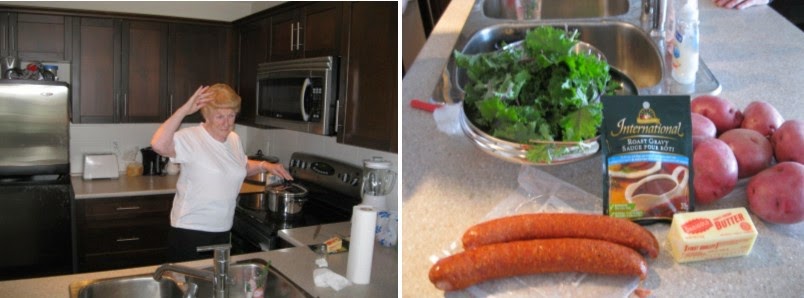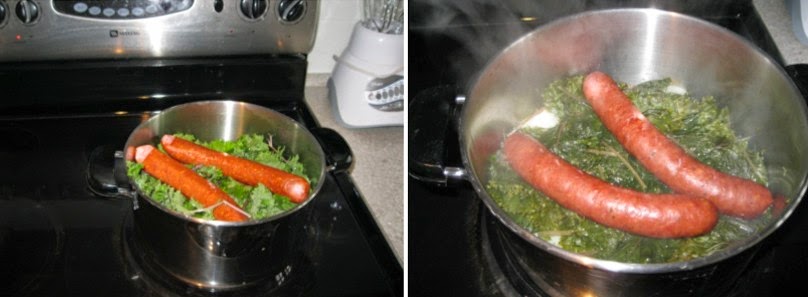 |
| Red Russian Kale |
Antagonistic Plants to Kale: Beans, Strawberries, Tomatoes
A Cool Weather Plant - Kale is a cool weather plant and tastes best after it has been exposed to frost, but it can be grown in any season. It can tolerate temperatures as low as -7 degrees Celsius, but will turn bitter and tough in temperatures over 27 degrees Celsius. When planting in the cool season, keep the kale in full sun, but in hot temperatures, move the container to a place that gets partial shade.
.
Planting & Spacing - To grow kale in a container, each plant must have at least 6 square inches of space. Kale prefers loamy soil with a pH between 5.5 to 6.8.
Caring for Kale - Keep the plants well watered and in moist soil, which will help make the leaves sweet and crisp. Apply fertilizer/compost every 6 to 8 weeks throughout the growing season.
Time until Harvest - Growth Time for Red Russian Kale, from transplanting to harvest, is between 40 and 60 days. Most other varieties of kale are ready to harvest between 55 to75 days.
How to Harvest Kale - Harvest individual leaves when the plants are eight to ten inches high, starting with the outside leaves first - or, harvest the entire plant by cutting the stocks two inches above the soil. New leaves will begin growing again in one to two weeks.
- If kale leaves are left too long before harvesting, they will become bitter and tough.
- Kale can stored in the fridge for up to a week by keeping it lightly moist in an unsealed plastic bag.
.
(Source: Kale: An Easy Beginner's Guide Growing, Gentle World)
.
***
. Kale - One cup of fresh chopped kale provides 80.4 mg of vitamin C.
.
Dark Leafy Greens are an excellent source of plant based Vit. A. One cup of Cooked Kale has 17,707 IU. Spinach, Collards, Turnip Greens, Dandelion Greens, Beet Greens, Swiss Chard and Pak Choi all have more than the recommended daily requirement in a single cup of cooked leafs. -- The Prepper Project: "What To Grow To Avoid Starvation and Malnutrition"
.
----------------------------------------------------------------------------------------------------------------------------
.
Borekole Recipe (Dutch Kale or Stamppot) (Click Pictures Below)
.
(Click the above pictures for Dutch Kale/Borekole/Stamp-pot Recipe)
.Red Kale Recipes -- Yummly
.
----------------------------------------------------------------------------------------------------------------------------
.
June 19, 2014
.
 Well,
the Balcony of Eden has been chugging along for about two months now
and it was time to harvest the kale, with the leaves having turned dark
in colour. We had been picking through it already for several weeks,
adding it into salads and making two good-sized meals of Stamppot
with the rest. Altogether we harvested 20 ounces of kale from that one
container. I did a little bit of Googling and found that Kale sells for $1.57/bunch, which is about 130grams or 4 & 1/2 ounces - the next time I go to the grocery store I'll check the prices here in Chilliwack and then weigh it on my scale at home.
Quite obviously, this was a financial disaster, since I bought the kale
as six pre-grown sprouts which cost a total of $8.94 plus 12% tax =
$10.01 expenses. Take off the $7.07 profit I made by growing it and I
have a net loss of $2.94 for my efforts. Uh oh! This is the road to
bankruptcy! Quite obviously, one must grow from seed or gardening
is not cost-effective. At that rate, I won't even pay off the $12.84
(incl. tax) for the container and 30litre bag of soil in which I grew
the kale in.
Well,
the Balcony of Eden has been chugging along for about two months now
and it was time to harvest the kale, with the leaves having turned dark
in colour. We had been picking through it already for several weeks,
adding it into salads and making two good-sized meals of Stamppot
with the rest. Altogether we harvested 20 ounces of kale from that one
container. I did a little bit of Googling and found that Kale sells for $1.57/bunch, which is about 130grams or 4 & 1/2 ounces - the next time I go to the grocery store I'll check the prices here in Chilliwack and then weigh it on my scale at home.
Quite obviously, this was a financial disaster, since I bought the kale
as six pre-grown sprouts which cost a total of $8.94 plus 12% tax =
$10.01 expenses. Take off the $7.07 profit I made by growing it and I
have a net loss of $2.94 for my efforts. Uh oh! This is the road to
bankruptcy! Quite obviously, one must grow from seed or gardening
is not cost-effective. At that rate, I won't even pay off the $12.84
(incl. tax) for the container and 30litre bag of soil in which I grew
the kale in..
 Heh,
don't get me wrong - I'm not doing this to make money or to feed
myself. This is more of an experiment than anything else, but I do want
to monitor the expenses versus yields so I can become a more effective
gardener. This was the first time I tried growing kale and it was a nice
plant to grow - easy to care for; it looked wonderfully lush out on the
balcony; and it tasted great. I'll plant kale again in the fall, since
kale is one of those plants which can withstand frost and actually even
tastes better after it has been exposed to frost. Of course, I will also
grow it from seed next time, which will lower my expenses to around
$2.00 - rather than the $10.01 I paid this time.
Heh,
don't get me wrong - I'm not doing this to make money or to feed
myself. This is more of an experiment than anything else, but I do want
to monitor the expenses versus yields so I can become a more effective
gardener. This was the first time I tried growing kale and it was a nice
plant to grow - easy to care for; it looked wonderfully lush out on the
balcony; and it tasted great. I'll plant kale again in the fall, since
kale is one of those plants which can withstand frost and actually even
tastes better after it has been exposed to frost. Of course, I will also
grow it from seed next time, which will lower my expenses to around
$2.00 - rather than the $10.01 I paid this time..
----------------------------------------------------------------------------------------------------------------------------
.
February 26, 2015
.
.
I also planted some kale in two of the large pots, hoping that they will sprout and grow early in the spring, so that by May I can harvest it and use the pots for a different crop during the summer. I'm not sure if it's too early in the year... perhaps we might get another frost, and perhaps not, but at least kale is a cool weather plant so I'm keeping my fingers crossed.
.
-----------------------------------------------------------------------------------------------------------------------------
.
April 7, 2015
.
The strawberries have perked up and the radishes and kale have poked up nicely, so I guess that's the silver lining to this cloud.
.
 |
| Radishes (Left) and Kale (Right) |
-----------------------------------------------------------------------------------------------------------------------------
.
April 22, 2015
.
I planted a few of the pepper seedlings I had growing on the window sill, and as you can see, the kale is filling into those two pots nicely. In a week or two, I should start some more seedlings so I have something ready to go into those containers once the kale comes out.
.
 |
| Peppers (Left) and Kale (Right) |






No comments:
Post a Comment